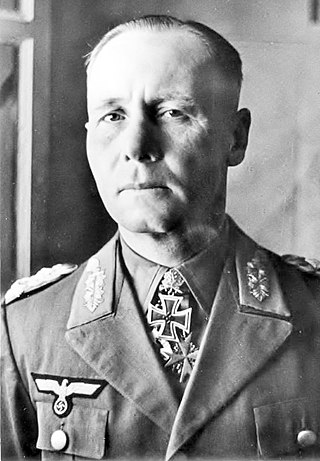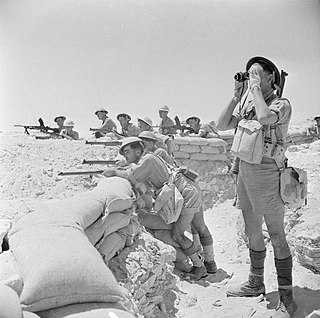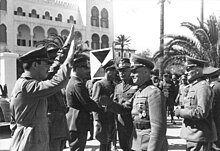
Johannes Erwin Eugen Rommel was a German Generalfeldmarschall during World War II. Popularly known as the Desert Fox, he served in the Wehrmacht of Nazi Germany, as well as in the Reichswehr of the Weimar Republic, and the army of Imperial Germany.

The German Africa Corps, commonly known as Afrika Korps, was the German expeditionary force in Africa during the North African campaign of World War II. First sent as a holding force to shore up the Italian defense of its African colonies, the formation fought on in Africa, under various appellations, from March 1941 until its surrender in May 1943. The unit's best known commander was Field Marshal Erwin Rommel.

The Battle of Kasserine Pass took place from 18-24 February 1943 at Kasserine Pass, a 2-mile-wide (3.2 km) gap in the Grand Dorsal chain of the Atlas Mountains in west central Tunisia. It was a part of the Tunisian campaign of World War II.

Operation Sonnenblume was the name given to the dispatch of German and Italian troops to North Africa in February 1941, during the Second World War. The Italian 10th Army had been destroyed by the British, Commonwealth, Empire and Allied Western Desert Force attacks during Operation Compass (9 December 1940 – 9 February 1941). The first units of the new Deutsches Afrikakorps (DAK), commanded by Generalleutnant Erwin Rommel, departed Naples for Africa and arrived on 11 February 1941. On 14 February, advanced units of the 5th Light Afrika Division, Aufklärungsbataillon 3 and Panzerjägerabteilung 39 arrived at the Libyan port of Tripoli and were sent immediately to the front line east of Sirte.

Tobruk or Tobruck is a port city on Libya's eastern Mediterranean coast, near the border with Egypt. It is the capital of the Butnan District and has a population of 120,000.

The North African campaign of World War II took place in North Africa from 10 June 1940 to 13 May 1943, fought between the Allies and the Axis Powers. It included campaigns in the Libyan and Egyptian deserts, in Morocco and Algeria, and in Tunisia. The Allied war effort was dominated by the British Commonwealth and exiles from German-occupied Europe. The United States officially entered the war in December 1941 and began direct military assistance in North Africa on 11 May 1942.

Operation Crusader was a military operation of the Western Desert campaign during World War II by the British Eighth Army against the Axis forces in North Africa commanded by Generalleutnant (Lieutenant-General) Erwin Rommel. The operation was intended to bypass Axis defences on the Egyptian–Libyan frontier, defeat the Axis armoured forces near Tobruk, raise the Siege of Tobruk and re-occupy Cyrenaica.

The Western Desert campaign took place in the deserts of Egypt and Libya and was the main theatre in the North African campaign of the Second World War. Military operations began in June 1940 with the Italian declaration of war and the Italian invasion of Egypt from Libya in September. Operation Compass, a five-day raid by the British in December 1940, was so successful that it led to the destruction of the Italian 10th Army over the following two months. Benito Mussolini sought help from Adolf Hitler, who sent a small German force to Tripoli under Directive 22. The Afrika Korps was formally under Italian command, as Italy was the main Axis power in the Mediterranean and North Africa.

Operation Brevity was a limited offensive conducted in mid-May 1941, during the Western Desert Campaign of the Second World War. Conceived by the commander-in-chief of the British Middle East Command, General Archibald Wavell, Brevity was intended to be a rapid blow against weak Axis front-line forces in the Sollum–Capuzzo–Bardia area of the border between Egypt and Libya. Although the operation got off to a promising start, throwing the Axis high command into confusion, most of its early gains were lost to local counter-attacks, and with German reinforcements being rushed to the front the operation was called off after one day.

The Battle of Gazala, also the Gazala Offensive was fought near the village of Gazala during the Western Desert Campaign of the Second World War, west of the port of Tobruk in Libya, from 26 May to 21 June 1942. Axis troops of the Panzerarmee Afrika consisting of German and Italian units fought the British Eighth Army composed mainly of British Commonwealth, Indian and Free French troops.
The 21st Panzer Division was a German armoured division best known for its role in the battles of the North African Campaign from 1941 to 1943 during World War II when it was one of the two armoured divisions making up the Deutsches Afrikakorps (DAK). It was first formed as the 5th Light Division in early 1941.
This is a timeline of the North African campaign of World War II.
El Agheila is a coastal city at the southern end of the Gulf of Sidra and Mediterranean Sea in far western Cyrenaica, Libya. In 1988 it was placed in Ajdabiya District; remaining there until 1995. It was removed from Ajdabiya District in 1995 but in 2001 it was placed back into Ajdabiya District. In 2007, El Agheila was placed within the enlarged Al Wahat District.

The Battle of Medenine was an Axis spoiling attack at Medenine in Tunisia on 6 March 1943. The operation was intended to delay an attack by the British Eighth Army on the Mareth Line. The British had been forewarned by Ultra decrypts of German wireless communications and rushed reinforcements from Tripoli and Benghazi before the Axis attack, which was a costly failure. General Erwin Rommel, the commander of Army Group Africa (Heeresgruppe Afrika), could not afford to lose forces needed for the defence of the Mareth Line and the effort was abandoned at dusk that day.

The Italian colonizationof Libya began in 1911 and it lasted until 1943. The country, which was previously an Ottoman possession, was occupied by Italy in 1911 after the Italo-Turkish War, which resulted in the establishment of two colonies: Italian Tripolitania and Italian Cyrenaica. In 1934, the two colonies were merged into one colony which was named the colony of Italian Libya. In 1937, this colony was divided into four provinces, and in 1939, the coastal provinces became a part of metropolitan Italy as the Fourth Shore. The colonization lasted until Libya's occupation by Allied forces in 1943, but it was not until the 1947 Paris Peace Treaty that Italy officially renounced all of its claims to Libya's territory.

The Battle of El Agheila was a brief engagement of the Western Desert Campaign of the Second World War. It took place in December 1942 between Allied forces of the Eighth Army and the Axis forces of the German-Italian Panzer Army, during the long Axis withdrawal from El Alamein to Tunis. The Eighth Army planned to outflank and trap the Axis forces as they withdrew to Tunis.

This is a timeline of events that stretched over the period of World War II in 1941, marked also by the beginning of Operation Barbarossa on the Eastern Front.

Operation Skorpion from 26 to 27 May 1941, was a military operation during the Western Desert Campaign of the Second World War. The operation was conducted by Axis forces under the command of Colonel Maximilian von Herff and British forces under Lieutenant-General William "Strafer" Gott. A counter-attack was made on British positions at Halfaya Pass in north-western Egypt, which had been captured during Operation Brevity (15–16 May).Unternehmen Skorpion was the second offensive operation commanded by Rommel in Africa.

The Axis capture of Tobruk, also known as the Fall of Tobruk and the Second Battle of Tobruk was part of the Western Desert campaign in Libya during the Second World War. The battle was fought by the Panzerarmee Afrika, a German–Italian military force in North Africa which included the Afrika Korps, against the British Eighth Army which comprised contingents from Britain, India, South Africa and other Allied nations.

US Naval Bases in North Africa were sea ports and air base used in North Africa during World War II by the United States Navy. The ports and air bases supplied the troops of the Allies armies in the flight against German and Italian forces in the North African campaign and Western Desert campaign. Later the bases supported the invasion of Italy. The ports and airfields were used after their surrender in Operation Torch. Amphibious Training Bases (ATB) were built in Algeria and Tunisia to prepare for the upcoming invasions. Seabees, United States Naval Construction Battalions, did most of the repair work, new construction, and maintaining work at the bases.



















